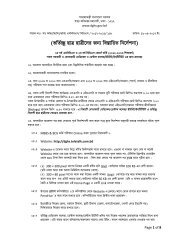Health Bulletin 2009
Health Bulletin 2009
Health Bulletin 2009
You also want an ePaper? Increase the reach of your titles
YUMPU automatically turns print PDFs into web optimized ePapers that Google loves.
2.<br />
3.<br />
4.<br />
5.<br />
6.<br />
7.<br />
8.<br />
9.<br />
GLP (Good Laboratory Practice) 10 ‐ 4 110 100 ‐ 50 140 ‐<br />
GLP (Good Laboratory Practice) 25 ‐ ‐ ‐ ‐ ‐ ‐ ‐ ‐<br />
GLP (Good Laboratory Practice) 20 ‐ ‐ ‐ ‐ ‐ ‐ ‐ ‐<br />
GLP (Good Laboratory Practice) 14 ‐ ‐ ‐ ‐ ‐ ‐ ‐ ‐<br />
GLP (Good Laboratory Practice) 5 ‐ 20 60 40 ‐ ‐ ‐ 240<br />
Computer Training (Refresher) 14 6 2 13 ‐ ‐ 25 50 ‐<br />
Security Management Training 5 ‐ ‐ ‐ ‐ ‐ ‐ ‐ 30<br />
English Language Training 28 ‐ ‐ ‐ ‐ 40 51 ‐ ‐<br />
Source: IPH, Mohakhali, Dhaka<br />
Diagnosis of bronchiolitis may be masked under cover of pneumonia leading to improper<br />
management: findings of ICMH study<br />
Bronchiolitis remains a major public health problem throughout the world exerting significant morbidity<br />
and mortality. Bronchiolitis due to Respiratory syncytial virus (RSV) remains a significant cause of<br />
respiratory disease all over the world including South-East Asian countries like India and Pakistan. It<br />
is estimated that proportional morbidity among the infants of Bangladesh due to respiratory diseases<br />
is 45%. In 2001-2002, epidemic of bronchiolitis was first reported in the country and high rate of this<br />
disease continued to prevail over the next five years. A recent study by Kabir, et al of Institute of Child<br />
and Mother <strong>Health</strong> shows 21% prevalence of bronchiolitis among the u-5 children who attended<br />
different<br />
hospitals. It is found that nearly 95% of bronchiolitis cases are of viral origin, RSV being the<br />
commonest. The diagnosis of bronchiolitis is most often made on clinical grounds and the criteria may<br />
vary. Very simply, the first attack of wheezing in a previously healthy child of less than two years of<br />
age or for a diverse criteria with coryzal symptoms followed by rapid onset of wheeze, fever,<br />
tachypnea, chest retractions, crepitation, ronchi with radiographic evidence of chesthyperinflation. The<br />
study undertook middle line as the diagnostic criteria for<br />
bronchiolitis (runny nose followed by breathing difficulty, chest indrawing and rhonchi (on auscultation)<br />
in children aged less than 2 years. Misdiagnosis of bronchiolitis as pneumonia has been observed,<br />
where antibiotics, have been used indiscriminately in 99% cases. Proportion of costly antibiotics, such<br />
as, ceftriaxone, a third generation cephalosporine, was in high proportion. Treatment for bronchiolitis<br />
require home management (in milder cases) and oxygen therapy or in severe cases measures such<br />
as nebulized salbutamol, adrenaline, corticosteroids, aerosolized ribavirin, hypertonic saline and in<br />
some cases critical management in pediatric intensive care unit (PICU). However, antibiotics remain a<br />
common practice in treating bronchiolitis despite the rare likelihood of bacterial infection. Use of<br />
antibiotics increases treatment cost and facilitates bacterial resistance. A recent multi-centre<br />
randomized control trial conducted by Kabir, et al have shown that managing acute bronchiolitis<br />
75



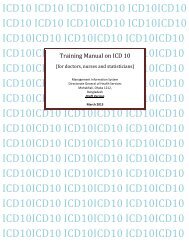




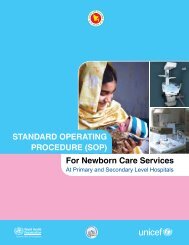
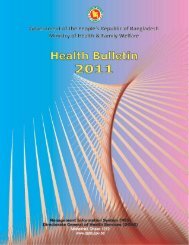
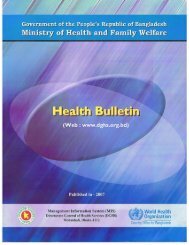
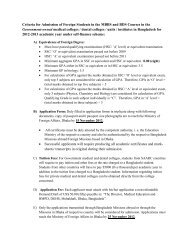
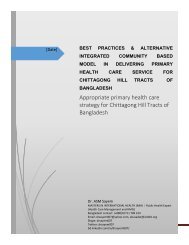
![Bangladesh Demographic and Health Survey 2007 [FR207]](https://img.yumpu.com/38440445/1/190x257/bangladesh-demographic-and-health-survey-2007-fr207.jpg?quality=85)
